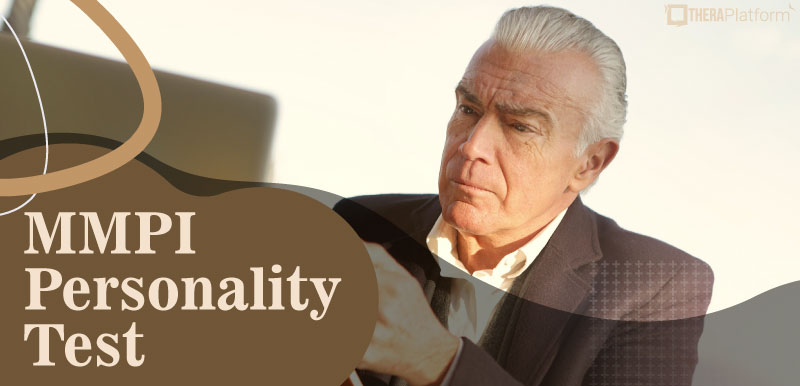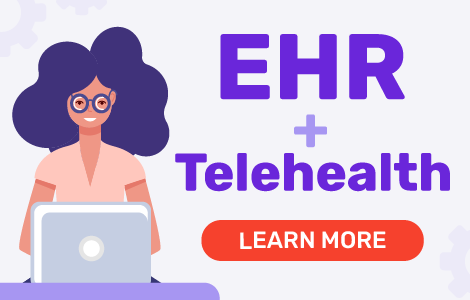Projective Tests

Projective tests involve a client projecting themselves onto an ambiguous object such as a drawing or image. Where intellectual and objective personality tests have questions and specific answers that result in specific labels, in projective testing, the answers can be as varied as the human race. This allows for more detailed information to be gathered about the individual.
Summary
- Projective tests offer insight into the subconscious. Unlike objective tests, projective tests like the Rorschach and Thematic Apperception Test (TAT) tap into unconscious thoughts, offering a deeper look into a client's emotions, trauma, and inner conflicts.
- Limitations include subjectivity and high cost. Due to the lack of standardization and need for extensive clinician training, projective tests can be time-consuming, expensive, and open to interpretation bias.
- Popular projective methods use drawing and storytelling: Tests like House-Tree-Person (HTP) and Draw-a-Person help assess emotional and developmental functioning through client-created images and narratives. Download my free emotional literacy worksheets.
- Only qualified professionals can administer them. Due to the complexity of interpretation, most projective tests—especially the Rorschach—can only be administered by licensed psychologists with specialized training. Using an EHR can help professionals manage their tests with ease.
Streamline your practice with One EHR
- Scheduling
- Flexible notes
- Template library
- Billing & payments
- Insurance claims
- Client portal
- Telehealth
- E-fax

Potential problems with projective tests
Lack of standardization of projective tests
A concern frequently cited with projective testing is that people giving the test may administer and/or interpret the tests differently causing the tests to yield different results. Unlike objective tests, there is no specific key to scoring. Sometimes specific guidelines or methods to interpretation and administration are used, but the human component plays a larger part.
Limitations on who can administer projective test
Because of the ambiguity of the testing stimulus and the unstructured nature of projective testing, professionals must be highly trained and qualified to administer and interpret the results of projective tests. Some tests require specific levels of degrees in specialties as well as training courses. In most U.S. states, projective tests can only be administered by individuals holding a doctoral degree in psychology and a license as a psychologist.
Limitations due to time and cost requirements
Intense interviewing and analysis is required to draw conclusions from projective techniques. These tests cannot simply be run through an algorithm and then printed out. They must be analyzed and compared with guidelines or standards for scoring. This time-intensive requirement coupled with the need for highly trained and degreed professionals makes it an extremely expensive process as well as limiting for many.
Practice Management + EHR + Telehealth
Manage more in less time in your practice with TheraPlatform
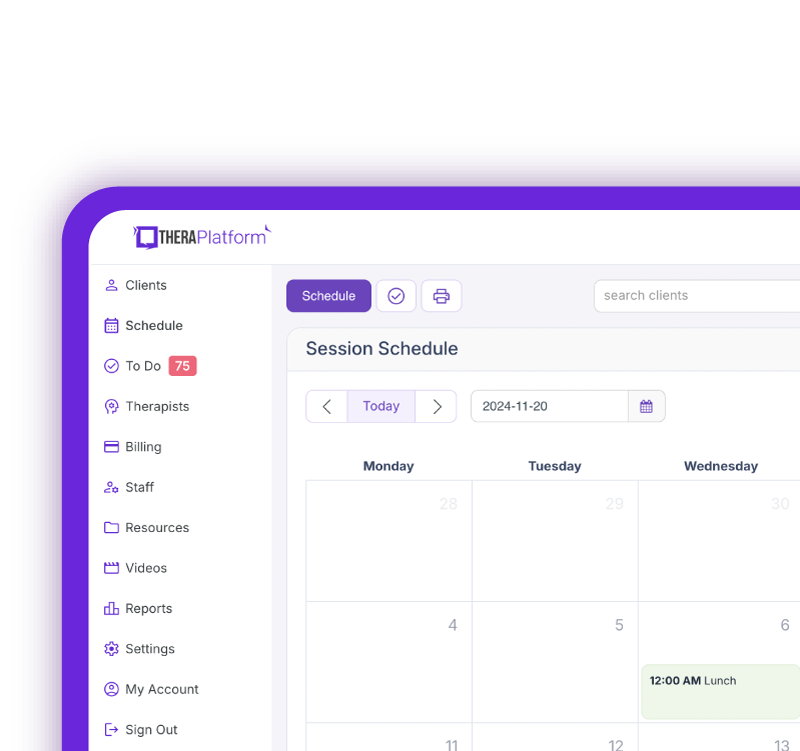
Benefits of Projective Testing
Study of conscious and subconscious
Objective testing requires the client to answer questions using what they are consciously aware of. However, we know that many people don’t just struggle with things they are aware of, they may have trauma or other struggles that are suppressed by the protective measures of the brain. Objective tests may not be able to tease these things out while projective measures are designed specifically for this purpose.
Mitigate social desirability effect
Because the person is unlikely to guess how each aspect is being measured, behavior should be more natural and reliable. When individuals answer the multiple choice style questions of objective testing, it is easy to tell which choices are more “socially acceptable” than others. This effect can lead to invalid profiles in objective testing with validity measures or can lead to highly inaccurate profiles.
Projective test examples
While not an exhaustive list, we will talk about four commonly utilized projective tests below.
House-Tree-Person
The HouseTree-Person (HTP) test helps with assessing personality traits. Based on the Draw-a-Man test from 1926, it was initially thought to evaluate the intelligence of children. However, it has been adapted as a form of evaluating a person through the self-expressive medium of art by John Buck, first in1948 and then updated in 1969.
In this projective test, the individual (as young as three years old) is asked to draw the best house they can. They may need to be reassured that it isn’t their drawing abilities being tested and may have some hesitance. After the house is completed, they are asked to draw a tree, then a person.
The key in projective testing is not only what is drawn but why, so it is essential. After the individual draws the objects asked for, the administrator then asks a series of primarily standardized questions about the drawings.
The administrator can ask probing questions if appropriate but should make sure to ask the standard questions like:
- Is the tree alive?
- Is it a happy house?
- How does the house feel?
- What is the house made of?
- How does the person feel?
As with all projective tests, interpretation of the HTP is complicated. Unlike objective tests, which typically have a key and set interpretations, projective testing requires the use of qualitative interpretation, clinical judgment, appropriate training, and experience. Additionally, the clinician can utilize this time to assess behavior during the test administration and determine things like openness to treatment, attention difficulties, and other clinical observations. It is difficult to argue that this test is valid as the validity is heavily determined by the individual practitioner’s subjective interpretation, however, many clinicians argue the helpfulness of this assessment in the evaluation process of clients, especially those who may be hesitant to talk or struggle to put their feelings into words.
Draw a Person
The Draw-a-Person test was developed from the same Draw-a-man test as the HTP test and was intended to supplement intelligence testing for more nonverbal children. As with the HTP, it allows the test taker to respond by drawing, in this case, a person.
The test is typically administered with a clinician asking the individual to “draw a person doing something” normally the drawing should take about five minutes, and then you move on. However, you should use clinical judgment in this case.
Researchers have argued that DAP has two primary contexts for its use: the prediction of development and screening for emotional struggles. However, as with the HTP, measuring validity and reliability is difficult because it is interpreted subjectively rather than objectively. The drawing is measured by a few things; one is the presence of a discernible human figure and its appropriate attachments (arms, legs, etc.). The other is the presence of details like clothes, fingers, and thumbs.
Like the HTP, the DAP is only as reliable as the clinician administering it and it requires practice to become proficient in utilizing this projective test. After all, you can’t determine if a 7-year-old’s drawing is appropriate if it is the only example you have seen.
The DAP test is best used as part of a rounded assessment which includes a clinical ‘interview’ and other appropriate assessments. Within this context, it can provide helpful additional information and help to build a complete picture of a child’s abilities and thoughts.
Free Resources for Therapists
Click below and help yourself to peer-created resources:

Thematic Apperception Test
The Thematic Apperception Test (TAT) is different from the previous tests. The TAT consists of 20 cards, each depicting intentionally ambiguous interpersonal interaction pictures. The clinician indicates that the test taker should “make up a story around this picture”. Like all good stories, it should have a beginning, middle, and ending. Tell me how the people feel and what they are thinking.
The examiners write the responses for each card word for word. A typical administration includes eight cards and takes about 30-45 minutes to complete. No single, accepted scoring method exists for the TAT, which makes it more of a “clinical technique” than a testing method technically, however, anyone who works with children is familiar with the interpretation of play and storytelling and all of the important data that can be obtained using that method.
Storytelling can tell much about one’s interpersonal relationships and attitudes about the self, as well as any major conflicts related to emotions. This is the benefit of using the TAT in therapy. When you have individuals struggling with expressing themselves accurately, a projective administration can open up doors that would otherwise be difficult to access.
The most commonly accepted method of interpreting the TAT is what is known as the inspection technique.Essentially, the clinician reads through the stories and looks for repetitions, recurring themes, and elements. They may look for the central theme of the story, what the main character needs or does, the nature of conflicts described, etc.
Anything that can provide a picture of how the individual looks at the world and processes events can benefit a clinical understanding of the client.
Rorschach
If projective testing had a king, it’s safe to say the Rorschach would hold that title. Commonly known as the inkblot test, the Rorschach is essentially the celebrity of the psychological testing world. It is frequently referred to in legal TV shows and movies and is either loved or hated by clinicians.
One of the strongest arguments for the Rorschach test is that it is easily adaptable to any language or culture due to its nature. The Rorschach is just a series of ambiguous inkblots on cards, some in color, some in black and white. As with the other projective tests, it’s not only what is said about the blots that matters, but why that is what the individual sees.
The test consists of 10 blots administered to the subject, and the subject states what they see and why they see it. Multiple methods were created to interpret this, and John Exner utilized all of them to create a comprehensive method that is both lengthy and quantified to make the interpretation more reliable and valid.
This test is generally labeled a projective test, but it is important to note that the Rorschach isn’t strictly a projective test. The test assesses an individual’s perception of themselves, others, and the world around them as well as how they deal with complexity and stressful situations.
Because of the ambiguous nature of the Rorschach, there have been many controversial issues associated with it. However, the American Psychological Association published a meta-analysis in 2013 which confirmed the test’s validity and accuracy in many areas.
It is important to note that there are strict limitations on who can administer a Rorschach due to the complexity of administration and interpretation. Only professional psychologists specifically trained and practiced are qualified to administer and interpret this test.
Improving mental health assessment notes with EHR software
EHR software and practice management tools, such as TheraPlatform, offer numerous advantages in creating accurate, efficient, and organized notes.
Top 7 benefits of using EHR for notes management
Manually writing and storing notes can be cumbersome for many therapists. That process can be further exacerbated by simple document requests that include locating, faxing or scanning documents.
Features like customizable templates, secure storage, easy sharing, duplication, electronic signatures, and efax integration, streamline the note process, optimizing therapy documentation and workflows.
- Consistent notes with template library: EHRs equipped with a library of note templates enable therapists to create standardized and concise notes quickly. This feature ensures consistency across notes, making it easier to review client progress. Additionally, EHRs provide centralized storage and management of notes, enhancing accessibility and organization.
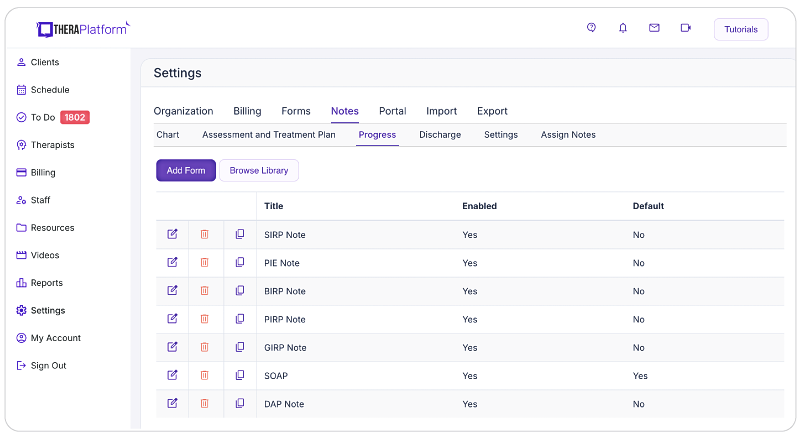
- Customizable notes: Not all EHRs offer customizable note templates tailored to therapists' unique needs. However, with a robust and user-friendly note template builder, therapists can customize note templates to align with their preferred note-taking style. This flexibility allows for efficient data entry, whether therapists prefer separating sections or using a single note field or checkboxes for mental status or techniques.

- HIPAA-compliant note storage: EHRs prioritize data security by implementing bank-level encryption to safeguard notes and other client information. TheraPlatform, for instance, ensures HIPAA compliance by offering signed, legally-binding Business Associate Agreements to protect Protected Health Information (PHI) between compliant entities.
- Seamless note sharing with clients: Clients may request access to their notes to better understand their treatment or keep them for record-keeping purposes. Using an EHR, therapists can securely share notes with clients, saving time compared to paper-based practices. TheraPlatform, a HIPAA-compliant EHR for therapists, facilitates secure note sharing with clients.

- Duplicate notes: In cases where the data remains the same across multiple sessions, duplicating notes can save time. This feature is particularly useful when clients exhibit repetitive behaviors or show minimal progress, allowing therapists to refer back to previous notes for accurate documentation.
- Client signatures made easy: EHRs streamline the process of requesting client signatures. TheraPlatform's Pro and Pro Plus plans enable therapists to request electronic signatures directly on notes. Clients can conveniently download and print the documents requiring their signatures.
- Easier faxing: TheraPlatform offers efax integration as an add-on feature, eliminating the need for toggling between multiple services. This integrated solution allows therapists to send and receive documents, including notes, via fax directly from TheraPlatform. Additionally, received faxes can be easily filed under the respective client's charts.
Additional tools and outcome measures to help with data collection and progress monitoring
Therapists can also take advantage of EHRs (such as TheraPlatform) that offer integrations with Wiley treatment planners to ensure consistent data collection on progress from session to session. The best part about partnering with a modern EHR is the time you save on formulating the actual notes and scoring.
What is Wiley Treatment Planner?
Wiley Treatment Planner is a widely used clinical resource designed to help mental health professionals and other therapists efficiently create treatment plans for their clients. In addition to treatment plans, the company also provides prewritten therapy notes for some diagnostic codes. It is part of the "PracticePlanners" series published by Wiley.
Features of Wiley Treatment Planner includes:
- Prewritten, evidence-based treatment goals, objectives, and interventions
- Treatment planners tailored to specific populations and problems, including adults, children, adolescents, couples, families, addictions, and more
- Alignment with the diagnostic criteria from the DSM-5 and ICD-10
- Prewritten therapy notes
Is there an online version of Wiley Treatment Planner and how can I get the Wiley Treatment Planner?
Wiley Treatment Planner company partnered with a select number of EHRs for mental health providers to make treatment planners available online. TheraPlatform’s EHR offers the Wiley Treatment Planner as an add-on for both assessment and treatment plans and therapy notes, such as notes. You can edit prewritten notes and add your own with any therapy template on TheraPlatform.
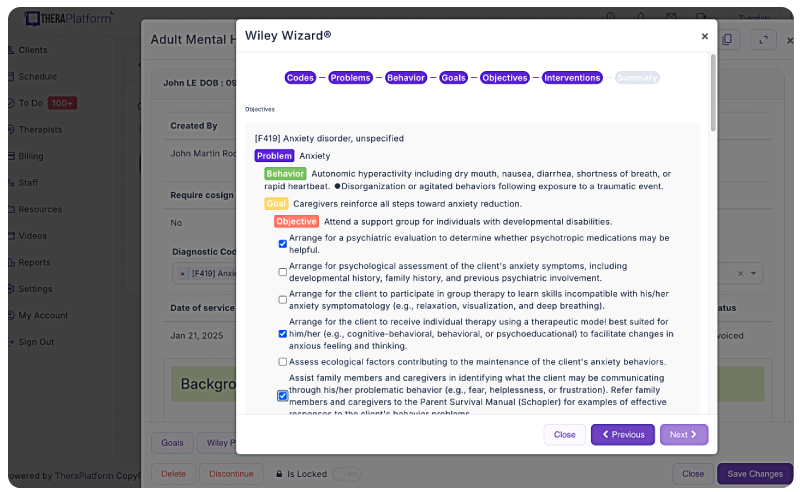
Save time with automatically scored outcome measures
Mental health therapists can use outcome measures to document progress, track a variety of key clinical indicators, helping providers make data-driven decisions, improve communication with clients, and improve client outcomes. Additionally, outcome measures help therapists adhere to compliance requirements and provide documentation needed to support reimbursement.
Watch this video to learn about how to autoscore outcome measures
→ Sign up for a Free Frial
While outcome measures clearly provide benefits to both clients and therapists, they can be time-consuming, especially if clinicians score responses manually.
However, many aspects of outcome measures can be automated through an EHR like TheraPlatform:
- Sending measurements: Common assessments such as the PHQ-9 or GAD-7 can be automatically sent to clients and stored in their records or they can be scheduled on regular intervals.
- Auto scoring: TheraPlatfrom automatically scores and sums totals for common outcome measures.
- Report building and analysis: Results can be analyzed over time, with visual charts showing progress on rates of severity and session-to-session progress.
By regularly using these measures, therapists can gain valuable insights, tailor interventions, and improve client outcomes while demonstrating the effectiveness of their care without manual entry.
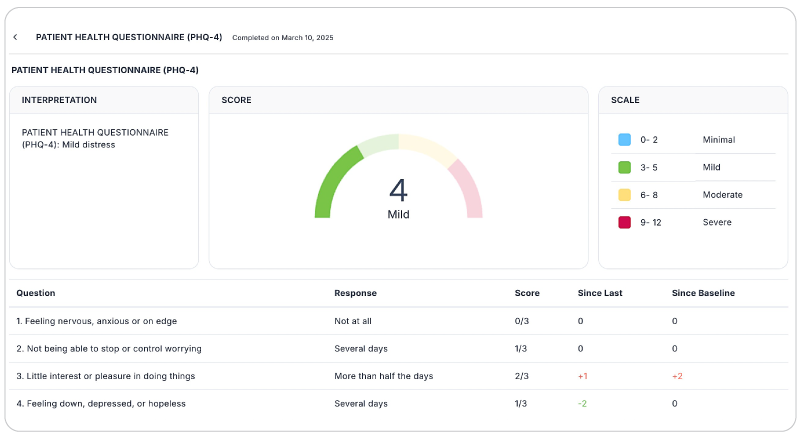
By leveraging the capabilities of EHR software like TheraPlatform, therapists can enhance the accuracy, efficiency, and accessibility of their notes, allowing them more time to enhance client care.
Streamline your practice with One EHR
- Scheduling
- Flexible notes
- Template library
- Billing & payments
- Insurance claims
- Client portal
- Telehealth
- E-fax

Resources
Theraplatform is an all-in-one EHR, practice management and teletherapy solution with AI-powered note taking features that allows you to focus more on patient care. With a 30-day free trial, you have the opportunity to experience Theraplatform for yourself with no credit card required. Cancel anytime. They also support different industries including mental and behavioral health therapists in group practices and solo practices.
More resources
- Therapy resources and worksheets
- Therapy private practice courses
- Ultimate teletherapy ebook
- The Ultimate Insurance Billing Guide for Therapists
- The Ultimate Guide to Starting a Private Therapy Practice
- Mental health credentialing
- Insurance billing 101
- Practice management tools
- Behavioral Health tools

